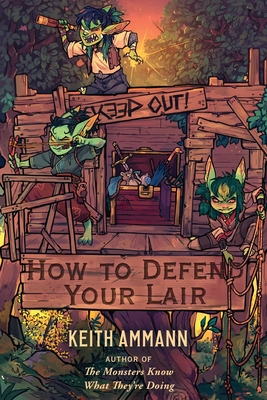
How to Defend Your Lair
by Keith Ammann
Keith Ammann's new book is a GM tool to help a GM make NPC lairs better. More logical, more realistic, and based on principles of real-world (and yes, magical world) security practices instead of dungeon and adventure design principles. How would a big bad evil wizard actually protect his spellbooks, or his treasury, or his life? How would the ruthless assassin's guild head protect her assassins, her big book of client names, and her escape route? GM long enough and you can come up with some ideas. With this book you can organize the approach based on real world principles and a sensible and logical approach.
It's very good stuff. The book consists of a look at concentric security all the way from detecting threats to reacting to them, to responses after, and escape when things fail. Patrolling, gathering information, how to secure your front and back doors, etc. - it's all there. And it is sufficiently generic that only a cursory knowledge of D&D 5th edition will be enough to make use of it. You'll learn when mounted and foot patrols make sense, how to arrange your reaction force, what kind of numbers are needed to provide how many patrols in a given time window, etc. It's both concrete usable information and higher-level concepts so you understand how and why.
The end of the book is a bunch of example lairs. They're all good. I won't spoil them except to say that you'll need your thinking cap on to penetrate security on them.
Two things I found less than valuable in the book - interrogation, and value assessment.
There is an entire chapter on how to interrogate people. Interesting, and based on what I've read from actual interrogators, it seems workable and accurate. However, what are you going to use this for? You'd need captive players and a lot of interest in doing one on one questioning of them by the GM to get them to reveal information. In the hands of a player, this might make for more compelling questioning than the usual ". . . or we'll kill you!" threats and poor questions. But I don't see that coming up. So if a GM really isn't going to get to use this, and it's a book aimed at a GM to make NPCs more believable and effective, it's not really valuable enough to justify a whole chapter. Again, it's good stuff, but it doesn't belong.
I'm also a little less sold on putting number values on what is valuable to create a score. The author recommends that for every item of value, you assign a score based on different value measurements - basically how much the possessor values the thing or fears losing the thing. Okay, great. But do I really need to know if something is a 6, or an 8, or a 9? I can see a simplified system working better - rank the things the NPC has in rough order of value. Then just protect them in that order. Don't protect item #3 less than item #1 on the top 5, say. It's an attempt to put a number on a subjective value and do something with that number. It just doesn't seem necessary to get the job done.
How adversarial is it? I'd say, little to not at all. It's not set up from a "GM vs. players" approach, in my opinion. It's more like making the NPCs use the most effective and logical tactics and strategy to protect their lairs. Nothing is stopping you from making the foes easier or harder even as you do so. Or from having NPCs use the wrong tactics because they'd lack the understanding (or personality) to use the better ones. It feels more like making sure the GM is making decisions from a position of knowledge than from a position of opposition.
This book can make a good player tool, as well, if you're not the type to figure out how to run effective fortified-area penetration missions but want to know how. Although the entire perspective is from someone trying to stop penetration, if you know what they're afraid of happening, you can try to make that happen. And detect more easily when someone hasn't figured out their vulnerability!
Overall: I like the book. I'm very glad I purchased it and it is having a positive effect on my gaming. Recommended.
Are there illustrations? Would it work well as an audio book?
ReplyDeleteHalf of the book is example lairs with maps, so that portion . . . not so much. The first half would be fine, I'd expect.
DeleteI'll have to check it out. His previous books were so 5th edition specific that I found them unusable, so I'm glad to hear this is generic.
ReplyDelete